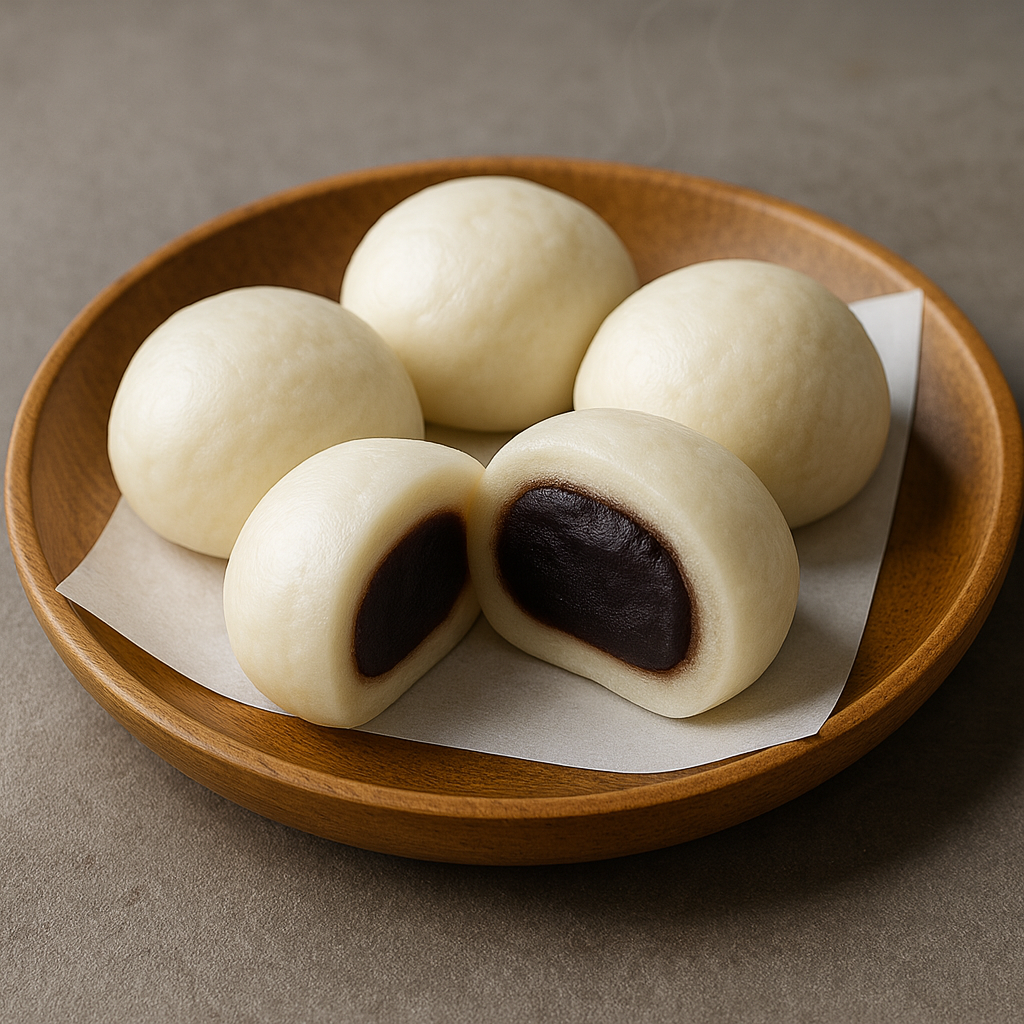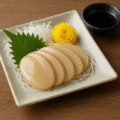しだみだんご(岩手・菓子)の特徴
“しだみ(どんぐり)”の滋味をいかす、素朴な郷土菓子です
「しだみ」はどんぐりのことを指し、渋抜きをした実に砂糖を加えてだんご状にしたもの、またはそれを餡にして小麦粉の生地で包む作り方があります。ほろりとした食感と香ばしさ、やさしい甘さが広がります。
救荒の知恵から生まれ、いまは“自然食の甘味”として親しまれます
凶作時にも備えられる保存食として受け継がれ、現代では自然志向のおやつとして再評価されています。丁寧なアク抜きが美味しさの鍵になります。
しだみだんご(岩手・菓子) レシピ
材料(5人分目安)
- しだみ(どんぐり・殻と渋皮を除いた正味) … 250g
- 重曹(または木灰の灰汁) … 小さじ1(アク抜き用)
- 砂糖 … 80〜120g(好みで)
- 塩 … ひとつまみ
包あん用の小麦生地(※包むタイプを作る場合)
- 薄力粉 … 200g
- 塩 … ひとつまみ
- 水 … 100〜130ml(生地の固さで加減)
仕上げ
- 黒砂糖(またはきなこ) … 適量(まぶし用・任意)
下ごしらえ(しだみのアク抜き)
- 殻を割り、渋皮を外す。大きい実は半分に割る。
- 鍋に実とたっぷりの水、重曹を入れ弱めの中火で10分ほど煮る。湯を捨て、水を替えて同様に2〜3回繰り返す(渋みが抜けるまで)。
- 水にさらして渋みを確認し、水気をよく切る。フードプロセッサーまたはすり鉢で粗〜中細にする。
しだみ餡(共通)
- 鍋にしだみ・砂糖・塩少々を入れ、弱火で練る。ぽってり持ち上がる硬さで止め、粗熱を取る。
作り方A(包あんタイプ:小麦生地で包む)
- 小麦生地:薄力粉・塩に水を少しずつ加え、耳たぶ程度にこねる。濡れ布巾をかけ10分休ませる。
- 分割:生地を10〜12等分、餡も同数に丸める。
- 包む:生地を円形にのばし、餡を包んでとじ目を下に丸める。
- 加熱:蒸し器8〜10分加熱する。
- 仕上げ:好みで黒砂糖をまぶす、またはきなこをふる。
作り方B(だんごタイプ:しだみ+砂糖のみ)
- 成形:しだみ餡を直径2.5〜3cmに丸める(やわらかければ少量の片栗粉を加えて調整可)。
- 仕上げ:黒砂糖を薄くまぶす、またはそのまま供する。
シェフのワンポイントアドバイス
- アク抜きは湯替えを丁寧に。渋みが残るとえぐみになります。味見しながら回数を調整してください。
- 餡は練りすぎると油分が分離しやすいので、ぽってりまとまったら止めます。
- 包あん生地は“やややわらかめ”が包みやすい。べたつくときは打ち粉で調整。
栄養価(1人分の目安)
- エネルギー … 220〜340 kcal
- たんぱく質 … 4〜6 g
- 脂質 … 4〜12 g(しだみ由来)
- 炭水化物 … 35〜55 g
- 食物繊維・ミネラル … しだみ由来
歴史
“しだみ=どんぐり”。救荒から生まれた保存の知恵です
凶作に備え、どんぐりを茹でて乾かし、必要時に灰汁や重曹で渋抜きして用いる習慣が根づきました。砂糖を加えてそのまま丸める、あるいは餡にして小麦生地で包む作り方が伝わっています。
自然食として再評価され、家庭の甘味として受け継がれます
栄養と保存性に優れる実として重宝され、近年は自然志向の流れの中で見直されています。丁寧な下処理と素朴な甘さが、郷土の味をいまに伝えています。
English Version
Features of Shidami Dango (Iwate • Confection)
A humble local sweet that showcases the wholesome flavor of “shidami” (acorns)
“Shidami” refers to acorns. After leaching out bitterness, the nuts are sweetened and shaped into dumplings, or the sweet acorn paste is used as a filling wrapped in a simple wheat dough. The result offers a gently crumbly texture, toasty aroma, and soft sweetness.
Born from famine wisdom, now enjoyed as a natural sweet
Passed down as a preserved food to rely on in lean years, shidami dango is now appreciated as a nature-forward treat. Careful astringency removal is the key to good flavor.
Shidami Dango (Iwate • Confection) – Recipe
Ingredients (Serves 5, approx.)
- Shidami (acorns, shelled & skinned; net) … 250 g
- Baking soda (or wood-ash lye) … 1 tsp (for leaching)
- Sugar … 80–120 g (to taste)
- Salt … a pinch
Wheat dough for filled type (optional)
- All-purpose flour … 200 g
- Salt … a pinch
- Water … 100–130 ml (adjust for dough firmness)
Finishing
- Dark brown sugar (or kinako) … as needed (for dusting, optional)
Prepping the acorns (leaching)
- Crack the shells and remove the brown inner skins. Halve larger nuts.
- Put the nuts, plenty of water, and baking soda in a pot; simmer gently for about 10 minutes. Drain, change to fresh water, and repeat 2–3 times until the bitterness is gone.
- Rinse in fresh water and taste to confirm bitterness is removed. Drain well. Grind in a food processor or mortar to a coarse–medium paste.
Shidami paste (common)
- In a small pot, combine the acorn paste, sugar, and a pinch of salt. Stir over low heat until it thickens to a scoopable, “plops back” consistency. Cool.
Method A (filled type: wrap paste in wheat dough)
- Dough: Mix flour and salt; add water gradually and knead to earlobe softness. Cover with a damp cloth and rest 10 minutes.
- Divide: Portion the dough into 10–12 pieces; roll the same number of shidami paste balls.
- Wrap: Flatten a dough piece, enclose a paste ball, and seal with the seam down.
- Cook: Steam for 8–10 minutes.
- Finish: Dust lightly with dark brown sugar or kinako if desired.
Method B (dumpling type: acorn paste only)
- Shape: Roll the shidami paste into 2.5–3 cm balls (if too soft, mix in a little potato starch).
- Finish: Lightly dust with dark brown sugar—or serve as is.
Chef’s Tips
- Be meticulous with water changes during leaching; any remaining tannins will taste harsh. Adjust repetitions by tasting.
- Do not overwork the paste once thick—overmixing can cause the oils to separate.
- For the filled dough, slightly soft dough wraps easier; use a light dusting of flour if tacky.
Nutrition (per serving, approx.)
- Energy … 220–340 kcal
- Protein … 4–6 g
- Fat … 4–12 g (from acorns)
- Carbohydrates … 35–55 g
- Dietary fiber & minerals … from acorns
History
“Shidami = acorns”: preservation wisdom from times of need
To prepare for poor harvests, acorns were boiled, dried, and later de-bittered with ash lye or baking soda. The sweetened paste was eaten as simple balls or wrapped in wheat dough as filled dumplings.
Reappraised as a natural food, carried on as a home sweet
Nutritious and storable, acorns earned a lasting place in regional foodways. Today, careful prep and gentle sweetness keep this rustic taste alive.



何でも質問してください!